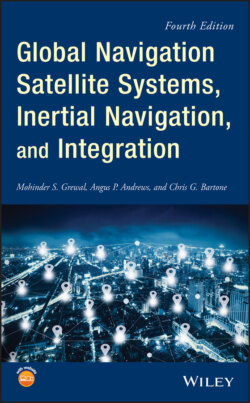Читать книгу Global Navigation Satellite Systems, Inertial Navigation, and Integration - Mohinder S. Grewal - Страница 55
2.2.1 Systems Other than GNSS
ОглавлениеIn many parts of the Globe, GNSS signals have replaced other terrestrial radionavigation systems, such as long‐range navigation‐version C (LORAN‐C) signals produced by three or more LORAN signal sources positioned at fixed, known terrestrial locations for outside‐the‐building location determination. A LORAN‐C system relies on a plurality of ground‐based signal towers, preferably spaced 100–300 km apart, that transmit distinguishable electromagnetic signals that are received and processed by an LORAN receiver system. A representative LORAN‐C system is discussed in the US DOT LORAN‐C User Handbook [1]. LORAN‐C signals use carrier frequencies of the order of 100 kHz and have maximum reception distances of hundreds of kilometers. An enhanced version of LORAN (eLORAN) provides ranging from each independent station and enhanced data. The low frequency and high transmitter power in LORAN provides for a diverse PNT capability. Although LORAN has been decommissioned in the United States, other counties and regions continue and operate LORAN for an alternative to other radionavigation systems.
There are other ground‐based radiowave signal systems suitable for PVT applications. These include Multi‐lateral DME, TACAN, US Air Force Joint Tactical Information Distribution System Relative Navigation (JTIDS Relnav), US Army Position Location and Reporting System (PLRS) (see summaries in [2], pp. 6, 7 and 35–60), and cellular radiolocation services.
Cellular radiolocation services provide for enhanced 911 (E911) and location‐based services (LBSs). These PVT solutions may be based on GNSS or range and bearing determination using the actual cell towers. Two‐way ranging (e.g. round trip timing [RTT]), and bearing determination may be determined by antenna sector or advanced phase angle‐of‐arrival (AOA) determination. Several standards in the 3GPP and Userplane community govern the implementation (http://www.3gpp.org/specifications and https://www.omaspecworks.org/).
